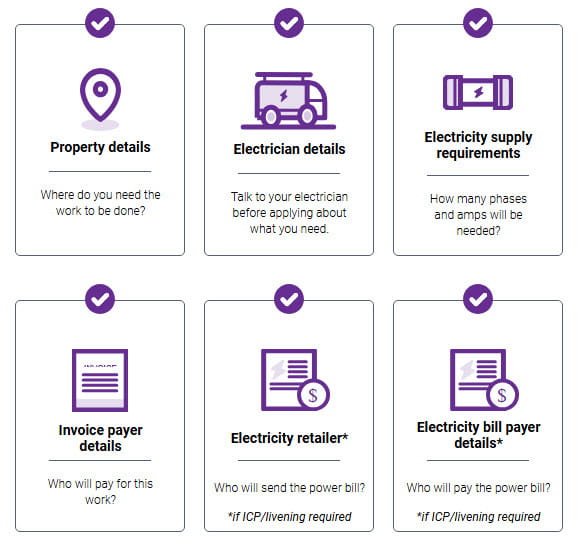What you need to know
What's involved?
Before you start, you need to get prepared. You’ll need:
- Property details – where do you need the work to be done?
- Electrician details – talk to your electrician about what you need
- Electricity supply requirements – how many phases and amps will be needed? Any equipment on site have a motor?
- Invoice payer details – who will pay for this work? This could be you or your agent (eg electrician)
- Electricity retailer – the business who sends the power bill?
- Electricity bill payer details – who will pay the power bill?

Site preparation information
To avoid delays, you need to have your site prepared. See below:
- Clear/safe vehicle access
- No dogs or obstructions
- Someone available to provide access if needed
Note - any additional site preparation instructions will be specified on the offer if required.
Documentation requirements
As part of the application process, you will be asked to supply documentation. These may be:
- Site plan
- Site diagram with cable route marked
- Marked up Google map
- Building plan
It is important this information is clear and correct to ensure a smooth triaging of your application. See examples of acceptable documentation here.
What qualifies for a new or modification request
 New connection
New connection
Request a new temporary or permanent connection on residential, commercial or industrial premises including:
- New individual connection
- Temporary Builders Supply
- New subdivision connection
 Connection modification
Connection modification
Request a change to an existing connection on residential, commercial or industrial premises including:
- Pillar relocation
- Convert service cable from overhead to underground
- Load group change
- Increase or decrease the capacity of the existing supply (one-phase to three-phase or vice versa)
- Permanent disconnection of the existing power supply
- Create a separate ICP for the same property/split
- Amalgamate multiple ICPs into one
- Decommissions
What will it cost?
Customer work is split into three pathways - network ready, simple and complex work.
Network ready – the existing network is fully able to support the connection. This is a streamlined process with standard pricing. Network ready is also typical as the final process in network development where we connect the customer to the network and liven the connection.
Simple – includes moderate complexity jobs that may require some network development, such as minor extensions or upgrades. Jobs can be standard priced or non-standard priced and may or may not require a small design contribution upfront.
Complex – requires a flexible delivery approach due to significant network development, complex design, commercial or legal requirements. They usually involve significant network development, a separate design phase and bespoke payment plans.
See our Electricity connection pricing page for more information.
How long will it take?
A new electricity connection on the Powerco network can take as little as two weeks for a network ready connection. Various factors impact how long the connection process takes for simple and complex work, and we’ll confirm the timeframe with you once you’ve accepted the offer and made payment.
Connection steps
Step 1 - Enquire and discuss
Get in touch with us to understand the connection process and begin your connection journey. We'll let you know what you need and how the process will work. You may also need to talk to your electrician to help gather the information you need.
Step 2 - Apply and explore
Submit your connection request using Powerco Connect. We'll review your application and let you know the pathway.
Step 3 - Design and approve
Simple and complex only
If your connection requires network design and build, we'll provide you with a quote tailored to your connection needs. See pricing schedule for details.
Step 4 - Deliver and build
Once the offer is accepted and paid, the job is scheduled and built.
Step 5 - Connect and complete
When construction is complete, the Customer Hub team manages the connection process. Our network connections team updates the registry and the job is closed.

Roles and responsibilities
Applicant - the person submitting the application
Customer - property owner or person the connection is for
Electrician - licensed person responsible for electrical work
Invoice payer - person or business paying any design or connection-related invoices/paying for the work
Electricity bill payer - person who will receive on-going electricity bills from their retailer
Applying on behalf of someone else
If you are an electrician or contractor requesting an electricity connection or modification, you can do this on behalf of someone else.
Electricians are responsible for:
And the customer is responsible for:
